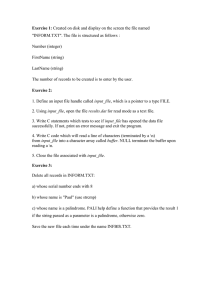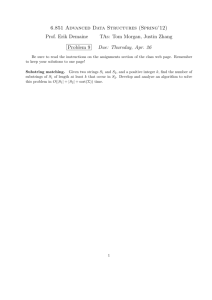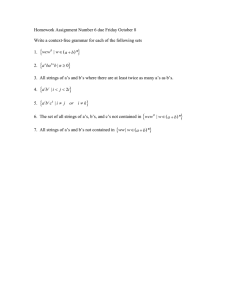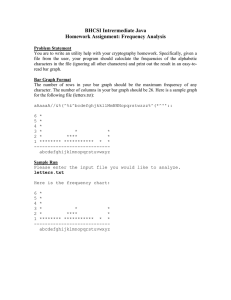ECE5610/CSC6220: Lab Exercise 3 (Pthread Programming) Name
advertisement
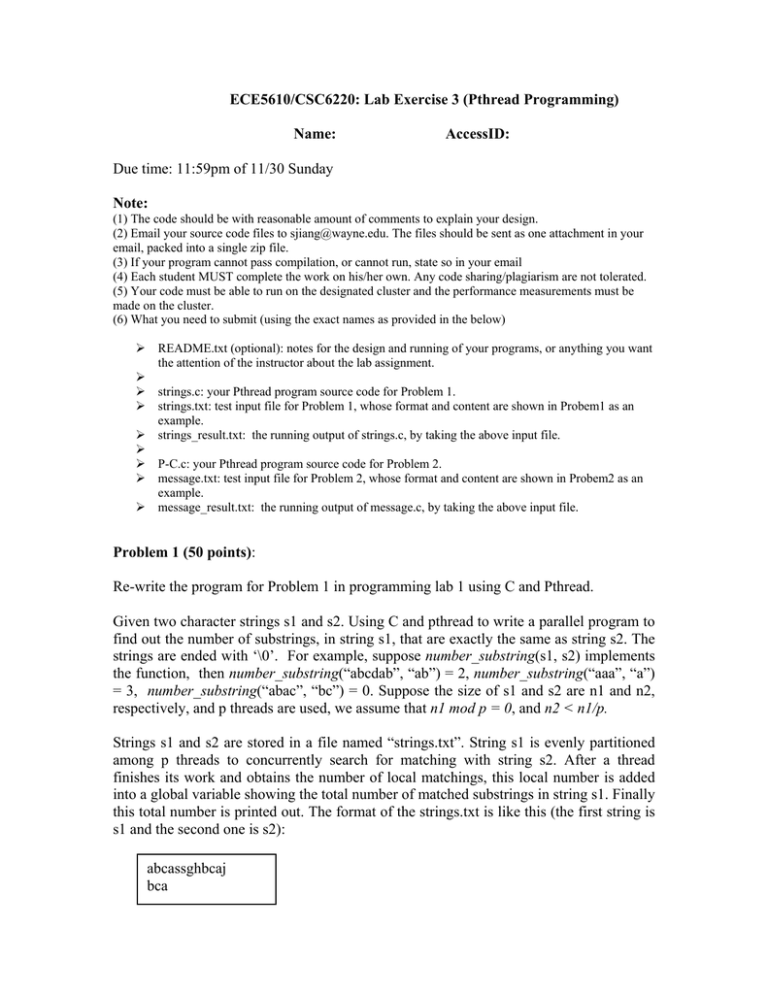
ECE5610/CSC6220: Lab Exercise 3 (Pthread Programming) Name: AccessID: Due time: 11:59pm of 11/30 Sunday Note: (1) The code should be with reasonable amount of comments to explain your design. (2) Email your source code files to sjiang@wayne.edu. The files should be sent as one attachment in your email, packed into a single zip file. (3) If your program cannot pass compilation, or cannot run, state so in your email (4) Each student MUST complete the work on his/her own. Any code sharing/plagiarism are not tolerated. (5) Your code must be able to run on the designated cluster and the performance measurements must be made on the cluster. (6) What you need to submit (using the exact names as provided in the below) ¾ ¾ ¾ ¾ ¾ ¾ ¾ ¾ ¾ README.txt (optional): notes for the design and running of your programs, or anything you want the attention of the instructor about the lab assignment. strings.c: your Pthread program source code for Problem 1. strings.txt: test input file for Problem 1, whose format and content are shown in Probem1 as an example. strings_result.txt: the running output of strings.c, by taking the above input file. P-C.c: your Pthread program source code for Problem 2. message.txt: test input file for Problem 2, whose format and content are shown in Probem2 as an example. message_result.txt: the running output of message.c, by taking the above input file. Problem 1 (50 points): Re-write the program for Problem 1 in programming lab 1 using C and Pthread. Given two character strings s1 and s2. Using C and pthread to write a parallel program to find out the number of substrings, in string s1, that are exactly the same as string s2. The strings are ended with ‘\0’. For example, suppose number_substring(s1, s2) implements the function, then number_substring(“abcdab”, “ab”) = 2, number_substring(“aaa”, “a”) = 3, number_substring(“abac”, “bc”) = 0. Suppose the size of s1 and s2 are n1 and n2, respectively, and p threads are used, we assume that n1 mod p = 0, and n2 < n1/p. Strings s1 and s2 are stored in a file named “strings.txt”. String s1 is evenly partitioned among p threads to concurrently search for matching with string s2. After a thread finishes its work and obtains the number of local matchings, this local number is added into a global variable showing the total number of matched substrings in string s1. Finally this total number is printed out. The format of the strings.txt is like this (the first string is s1 and the second one is s2): abcassghbcaj bca In the program, use #define to specify number of threads to be created. For example, #define NUM_THREADS 5 Problem 2 (50 points): Using mutual exclusion lock to implement a producer-consumer algorithm. Here we have two threads: one producer and one consumer. The producer reads characters one by one from a string stored in a file named “string.txt”, then writes sequentially these characters into a circular queue. Meanwhile, the consumer reads sequentially from the queue and prints them out in the same order. The diagram illustrates the process: upon completion of running the program, “Hello! World.” is printed on the screen. In the program, use #define to specify the size of the queue. For example, #define QUEUE_SIZE 5. Make sure to test your program with different queue sizes, including 1. Use the code presented in the class slides as a starting point of your work. Hello! World. message.txt producer W ! o l l consumer e Hel H
